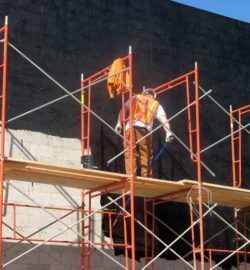USES
SEALMASTIC emulsion-type dampproofing coatings are ideal for reducing dampness and moisture infiltration through foundation walls, parapets, firewalls, tanks, culverts, cisterns, and bridge abutments. They are also applicable for stone-backing, above-grade cavity wall applications, and below-grade masonry wall dampproofing. The SEALMASTIC product line also helps to minimize internal structural damage from mildew and mold, and is compatible with ICF foam forms.
FEATURES/BENEFITS
- Adheres to damp or “green” surfaces … no waiting for concrete to thoroughly dry.
- Ready to use … no heating or thinning required; dries rapidly.
- Fast and economical way to protect concrete and masonry foundation walls from moisture penetration.
- Easy to apply … available in spray-, brush- or trowel-grades; meets a broad application range.
- Three application grades available for maximum versatility.
- VOC compliant.
PACKAGING
5 Gallon (18.9 Liter) Pails
55 Gallon (208.2 Liter) Drums
COVERAGE
SEALMASTIC TYPE I:
Approximately 70 – 100 ft.2/gal. (1.7 – 2.5 m2/L) per coat.
SEALMASTIC TYPE II/SEALMASTIC TYPE III:
Exterior below-grade dense surfaces, exterior below-grade porous surfaces, exterior above-grade surfaces
Approximately 40 – 50 ft.2/gal. (0.1 – 1.2 m2/L) (30 mils wet).
Coverage may vary due to porosity and condition of concrete.
SHELF LIFE
When stored indoors in original, unopened containers at temperatures between 40° – 90° F, optimum performance and best use is obtained within one year of date of manufacture.
SPECIFICATIONS
TYPE I
ASTM D1187, Type I
ASTM D1227, Type III, Class 1
TYPE II
ASTM D1187, Type I
ASTM D1227, Type II, Class 1
TYPE III
ASTM D1187, Type I
ASTM D1227, Type II, Class 1
All products comply with current federal, state, and local maximum allowable VOC requirements, including U.S. EPA, SCAQMD, and OTC.
TECHNICAL DATA
VOC Content: 0 g/L
APPLICATION
Surface Preparation
All surfaces to be coated must be thoroughly cleaned of all scale, loose mortar, dust, rust, dirt, oil, grease, and other foreign matter. Use a wire brush, sandblast, or other method in keeping with good construction practices. Before product application, fill voids, cracks, and holes in concrete with cement mortar and allow to dry. If conformance to an ASTM D41 primer is required, use SEALMASTIC SPRAY-MASTIC™ from W. R. MEADOWS. Allow prime-coat to dry tacky to touch prior to application of SEALMASTIC emulsion product. Only apply when temperatures are expected to remain above 50° F (10° C). Do not apply in rain or when rain is threatening for the next 24 hours.
Mixing
SEALMASTIC TYPE I and SEALMASTIC TYPE II should be thoroughly stirred in their respective containers prior to application. SEALMASTIC TYPE III can be applied directly from the container.
Exterior Below-Grade Dense Surfaces
Apply SEALMASTIC TYPE II by soft bristle brush or suitable spray equipment or SEALMASTIC TYPE III by trowel. Consult spray equipment manufacturer for instructions.
Product should be applied to properly prepared surfaces in a continuous, unbroken film (free of pinholes), filling and spreading around all joints, slots, and grooves and penetrating into all crevices, chases, reveals, soffits, and corners. Carry coating over the exposed footing’s top and outside edge, up to finished grade.
NOTE: Fillers, extenders, and additives in concrete mixes can produce a higher than normal porosity and, as a result, additional coverage coats may be required.
Exterior Below-Grade Porous Surfaces (Three Options):
Membrane System
For severe conditions or for added protection, apply one coat of SEALMASTIC TYPE II or SEALMASTIC TYPE III. Within four hours, apply REINFORCING FABRIC HCR from W. R. MEADOWS over all coating surfaces. Overlap all edges 3″ (76.2 mm) minimum. Press firmly into place without wrinkles. Application of second coat of SEALMASTIC TYPE II or SEALMASTIC TYPE III should be within 24 hours.
Two-Coat System
If conformance to an ASTM D41 primer is not required, use MEL-PRIME™ W/B from W. R. MEADOWS or a diluted coat of SEALMASTIC emulsion product one to one. Allow prime coat to dry tacky to touch and then apply SEALMASTIC TYPE III in one coat, as described above.
Parge-Coat System
Before application of SEALMASTIC, a parge-coat of cement mortar should be applied to the block wall. This coat should cover the bottom of the footings to grade level, forming a cove at the junction of the wall and footing. Once the parge-coat cures, apply one trowel-coat of SEALMASTIC TYPE III or two spray- or brush-coats of SEALMASTIC TYPE II as described above.
Backfilling
Backfilling should be done within 24 – 48 hours after application. No longer than seven days maximum should elapse. Be careful not to damage or rupture the film or displace coating or membranes. To assure maximum protection, PROTECTION COURSE and MEL-DRAIN™ from W. R. MEADOWS should be used. Prolonged exposure to ultraviolet light should be minimized.
Interior Above-Grade Surfaces
SEALMASTIC TYPE I, SEALMASTIC TYPE II, and SEALMASTIC TYPE III can be used individually or in combination for dampproofing the exterior face of interior walls in cavity wall construction.
Cleanup
While still wet, material may be removed with soap and water. Once dried, the material can be removed with kerosene or petroleum naptha. Solvent manufacturer precautions should be adhered to when using a solvent for cleanup.
PRECAUTIONS
Keep from freezing in the original container. Not intended as a waterproofing membrane. Maximum UV exposure time is 14 days. Maximum in-service temperature is 165° F (74° C). Read and follow application information and precautions.


